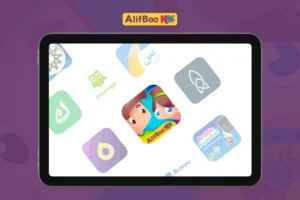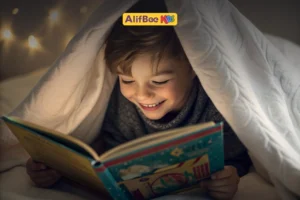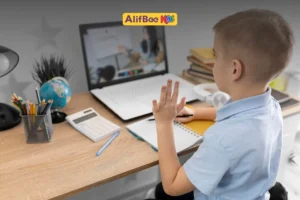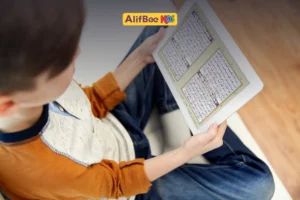Why Starting Early is the Key to Teaching Your Child Arabic at Home
You might wonder when the best time is to teach Arabic to your kids. Starting early gives your child the incredible advantage of naturally absorbing the language, making mastery as smooth as a gentle breeze. According to researchers, kids aged 2 to 13 can acquire a new language to a native-like level more readily than older learners.
At ages 2 or 3, your child likely learns at home, offering a golden opportunity brimming with benefits. You get to strengthen your special bond, tailor their learning to suit their unique personality and your family’s vision, and instill cherished cultural traditions and values. This nurtures a stronger sense of identity and deep cultural appreciation in your child.
(Don’t miss our in-depth blog on the remarkable benefits of teaching your child Arabic at home.)
In this article, we’ll walk you through exciting and effective ways to teach your kids Arabic at home. These methods are convenient and rewarding, ensuring your child acquires not only the language but also confidence in using it.
Start with the Basics
Teaching Arabic to your child begins with laying a solid foundation, and the basics are where the magic happens. Think of it as planting seeds for a flourishing garden of language skills.
The Importance of Alphabets and Sounds
The Arabic script is both beautiful and unique. Introducing your child to the Arabic letters and their sounds is the first step in making the language familiar and approachable. Each letter carries its own distinct sound and shape, so start with simple recognition. Sing songs about the Arabic alphabet or use playful rhymes to help your child memorize them effortlessly. Celebrate small milestones, like recognizing their first letter or pronouncing it correctly, to keep their enthusiasm alive.
Simple Vocabulary Building
Once your child feels comfortable with the letters and their sounds, start weaving in everyday vocabulary. Focus on words they encounter daily, like أسماء أفراد العائلة (family names), الألوان (colors), and أسماء الحيوانات (animal names). These words resonate with their immediate world, making the learning process both relatable and exciting. For example, teach them how to say قطة (cat) when playing with a toy cat or أحمر (red) when picking out crayons.
(Check 100 Arabic words that you can start teaching your kids today in this article: Top 100 Arabic Word Every Child Should Learn First)
Use Visual Aids
Children are visual learners, and incorporating colorful flashcards, illustrated posters, and engaging charts can make Arabic letters and vocabulary come alive. Hang an Arabic alphabet chart on the wall or place flashcards in their play area. When they see and interact with these visuals regularly, it reinforces what they’ve learned in a fun and non-intrusive way.
Practical Tip: Create a “Word of the Day” Calendar
Keep things fresh and exciting by introducing a new Arabic word every day. You can write the word on a colorful card, place it somewhere prominent, and use it in sentences throughout the day. For instance, if the word of the day is تفاحة (apple), say things like, “Would you like a تفاحة for your snack?” This simple routine makes learning consistent and fun, giving your child daily wins to celebrate.
Incorporate Arabic into Everyday Life
Bringing Arabic into your child’s daily routine transforms language learning from a chore into a natural, enjoyable experience. Everyday life holds countless opportunities to introduce Arabic in subtle yet impactful ways.
Label Common Items
Imagine your child seeing Arabic words wherever they turn—a sticky note on the ثلاجة (fridge), another on the كرسي (chair), or even one on their favorite لعبة (toy). Labeling household items with their Arabic names creates a constant visual reminder, helping your child associate the words with the objects they see and use every day. Make it a fun activity by letting your child decorate the labels or place them on the items themselves. These little notes soon become bridges to a richer vocabulary.
Practice Phrases
Beyond individual words, short phrases breathe life into language learning. Start with practical, everyday expressions like صباح الخير (Good morning), شكراً (Thank you), or أين الكتاب؟ (Where is the book?). These phrases not only teach your child how Arabic works in context but also make interactions more dynamic and exciting. Imagine their delight when they confidently greet you with السلام عليكم (Peace be upon you) each morning!
Use Arabic in Conversations
To truly integrate Arabic into your child’s life, use it during everyday moments. At breakfast, say, “هل تريد تفاحة؟” (Do you want an apple?). During playtime, ask, “أين الكرة؟” (Where is the ball?). Even simple phrases like “لنذهب إلى الحديقة” (Let’s go to the park) make Arabic feel like a natural part of their world. By hearing and using these phrases regularly, your child builds familiarity and confidence in speaking Arabic.
Practical Tip: Use Arabic Words for Items Your Child Interacts With Often
Children learn best through repetition and relevance. Focus on teaching Arabic words for things they use and love, like لعب (toys), كتب (books), or مأكولات (snacks). For instance, when giving them an apple, say تفاحة. Repeat the word often during the interaction: “خذ تفاحة. هل تحب التفاحة؟” (Take an apple. Do you like the apple?). The more they hear and use these words in context, the more they’ll remember them.
Make Learning Fun with Activities
Children learn best when they’re having fun, and what better way to teach Arabic than through playful and creative activities? By turning learning into a game, you make it something they’ll look forward to every day.
Games and Puzzles
Kids love games, so why not use them to teach Arabic? Arabic crossword puzzles, memory games, and matching games are perfect for building vocabulary and sharpening their cognitive skills. For instance, you could create a matching game where your child pairs Arabic words with their corresponding pictures, like pairing شمس (sun) with an image of the sun. These activities not only enhance their language skills but also spark their curiosity and keep them engaged for hours.
Songs and Rhymes
Music is a magical tool for learning, and Arabic nursery rhymes and songs are a treasure trove of fun and education. Sing along to classics like “الأبجدية العربية” (The Arabic Alphabet Song from AlifBee or play upbeat songs that teach numbers, colors, or animals. The repetitive nature of songs helps your child internalize pronunciation and rhythm without even realizing they’re learning. Plus, dancing and singing together turns it into a joyful bonding moment. (Check AlifBee Kids YouTube Channel for more songs on numbers, days of the week, vocabulary and more.)
DIY Crafts
Unleash your child’s creativity with hands-on DIY crafts that incorporate Arabic. Create Arabic letters using colorful clay, draw and decorate letters on cardboard, or even bake letter-shaped cookies. Activities like these help children recognize letters and shapes while having a blast. For example, making the letter أ with playdough and then learning a word that starts with أ, like أسد (lion), ties the craft directly to their learning.
Practical Tip: Introduce Rewards for Completing Arabic Learning Activities
Kids thrive on encouragement, so celebrate their efforts with small rewards. Create a chart where they earn a star or sticker for every completed activity. Once they reach a milestone, reward them with something they love, like extra playtime, a favorite snack, or a new storybook in Arabic. These rewards keep them motivated and make the learning process feel like an exciting adventure.
Leverage Technology and Apps
In today’s tech-savvy world, technology can be your greatest ally in teaching Arabic to your child. With interactive tools and engaging apps, learning Arabic becomes as easy as tapping a screen—and just as fun.
Best Apps for Arabic Learning
Arabic learning apps designed for kids are treasure troves of games, stories, and lessons tailored to their age and level. Apps like AlifBee Kids bring the magic of Arabic to life with colorful animations, catchy songs, and interactive activities. Whether your child is learning letters, building vocabulary, or exploring basic phrases, these apps make the process joyful and immersive. Plus, many apps offer progress tracking, so you can see how your child is advancing and celebrate their milestones.
Interactive Learning Tools
Beyond apps, digital tools like e-books, flashcards, and interactive quizzes can enrich your child’s learning experience. Arabic e-books with audio narration allow your child to hear native pronunciation as they follow along with the text. Digital flashcards with images and sounds make vocabulary practice a breeze. Interactive quizzes add a touch of challenge and reward, keeping kids engaged while reinforcing what they’ve learned.
Monitor Screen Time
While technology opens up incredible learning opportunities, moderation is key. Striking the right balance between digital learning and offline activities ensures your child gets the best of both worlds. Pair screen time with hands-on activities like crafts or games to create a holistic learning experience. For instance, after practicing Arabic letters on an app, encourage your child to write them out on paper or shape them with clay.
(Read our full article on how to turn Screen Time to Learning Time with AlifBee Kids here.)
Practical Tip: Schedule Specific Times for App UsageTo avoid over-reliance on screens, set designated times for using Arabic learning apps for kids. For example, schedule 20 minutes after breakfast or during quiet time in the evening. This routine helps your child anticipate and enjoy their learning sessions without feeling overwhelmed. Plus, having a set time makes it easier for you to monitor their progress and stay involved.
Build a Consistent Routine
Consistency is the secret ingredient to mastering any skill, and learning Arabic is no exception. By weaving Arabic into your child’s daily routine, you create a rhythm that makes learning feel natural and enjoyable.
Daily Practice
Set aside just 15–30 minutes each day for focused Arabic learning. These short, regular sessions keep your child engaged without overwhelming them. Whether it’s practicing a few letters, learning a new word, or playing a quick language game, daily practice builds a strong foundation over time. Make it a fun and cozy moment—perhaps right after breakfast or before bedtime—when your child is most receptive.
Weekend Focus
Weekends are the perfect time to dive deeper into Arabic. Use the extra time for extended activities like crafting Arabic letters, exploring an Arabic storybook, or playing family games in Arabic. You could even plan special cultural activities, like cooking a dish with Arabic instructions or learning an Arabic song together. These immersive experiences make weekends feel like mini adventures in the language.
Track Progress
Children love seeing their progress, and tracking their achievements keeps them motivated. Maintain a simple journal or checklist where you note milestones, like learning a new set of letters or mastering a phrase. Celebrate these moments with praise or a small reward to boost their confidence and encourage them to keep going.
Practical Tip: Use a Visual Progress Tracker
Make learning visible and exciting with a sticker chart or visual tracker. For every new word learned or activity completed, let your child add a sticker to the chart. Watching their progress grow day by day instills a sense of pride and accomplishment. You can even set goals, like earning a special reward after reaching a certain number of stickers.
Make It a Family Activity
Learning Arabic doesn’t have to be a solo journey for your child—it can be a joyful family adventure. By involving siblings, relatives, and even grandparents, you create an enriching environment where Arabic becomes a shared experience, strengthening both language skills and family bonds.
Involve Siblings or Relatives
When siblings or relatives join in, learning Arabic turns into a lively, interactive activity. Play games where everyone practices new words together or have a friendly competition to see who can recognize the most letters. Learning alongside others adds excitement and fosters a supportive atmosphere where everyone encourages one another to succeed. Even younger siblings can join in by learning simpler words, making it a family-wide celebration of progress.
Cultural Integration
Arabic isn’t just a language; it’s a gateway to rich cultural traditions. Bring these traditions to life in your home by cooking a traditional Arabic meal together, learning an Arabic dance, or celebrating cultural holidays with songs and stories in Arabic. Activities like these immerse your child in the language while deepening their appreciation for its cultural roots. Imagine the joy of preparing a dish like كبسة (kabsa) while naming ingredients in Arabic—it’s both fun and educational!
Storytelling in Arabic
Bedtime stories become magical when told in Arabic. Choose simple tales with repetitive phrases or familiar characters to captivate your child while introducing new words and phrases. Even if your Arabic isn’t perfect, your effort shows your child that learning is a shared journey. Over time, your child might even start retelling the stories back to you, building their confidence and creativity.
Practical Tip: Host Weekly Family Story Sessions
Dedicate one evening a week to a family story session where everyone practices Arabic together. Take turns reading lines from an Arabic book, or make up a story where each family member adds a sentence. These sessions not only improve language skills but also create treasured family memories.
Address Challenges with Patience
Learning Arabic at home is a wonderful journey, but like any journey, it comes with its bumps along the way. Staying patient and creative helps you navigate these challenges while keeping your child motivated and excited about learning.
Overcoming Resistance
It’s natural for kids to lose interest or feel frustrated at times. If your child resists learning, turn it into a playful experience rather than a task. Bring out a favorite toy and use it to act out an Arabic conversation, or play a guessing game where they identify objects around the house in Arabic. Sometimes a change of scenery, like learning outdoors or at the park, can reignite their enthusiasm. The key is to keep it light and fun, so they forget they’re “learning” and just enjoy the moment.
Celebrating Small Wins
Every step your child takes in learning Arabic is worth celebrating. Did they say their first full sentence? Recognize a tricky letter? Give them a high five, a sticker, or a warm hug to show how proud you are. These small celebrations build their confidence and make them feel excited to tackle the next milestone. Remember, progress is progress, no matter how small.
Adjust Your Methods
What works today might not work tomorrow, and that’s okay. Be flexible and willing to try different approaches. If flashcards lose their appeal, switch to an Arabic storybook or try an app with engaging games. Maybe they’d enjoy learning through music or crafts instead. By observing what sparks their interest, you can adapt your methods to suit their unique learning style.
Practical Tip: Keep Lessons Short and Engaging
Long lessons can feel overwhelming for kids, so aim for bite-sized sessions packed with fun. A 10-15 minute activity that captures their attention is far more effective than an hour-long lesson they struggle to sit through. Incorporate games, songs, or interactive tools to make each session feel like playtime rather than study time.
Final word
Teaching your child Arabic at home is an incredible journey filled with opportunities to bond, grow, and celebrate together. By starting with the basics, integrating Arabic into daily life, using fun activities, leveraging technology, building a consistent routine, involving the whole family, and addressing challenges with patience, you create a nurturing environment where your child can thrive in learning.
Remember, consistency and creativity are your greatest allies. With regular practice and imaginative approaches, Arabic learning transforms from a task into a joyful adventure. Every small step—whether it’s mastering a letter, singing a rhyme, or using a new word in conversation—is a building block toward your child’s success and confidence.
To make this journey even more exciting, explore the AlifBee Kids app, your perfect companion for teaching Arabic at home. Packed with engaging games, stories, and interactive tools, it offers everything you need to spark your child’s love for Arabic and keep them inspired every step of the way.
Start today, and watch your child embrace Arabic with joy, curiosity, and pride—one word, one phrase, one story at a time!





